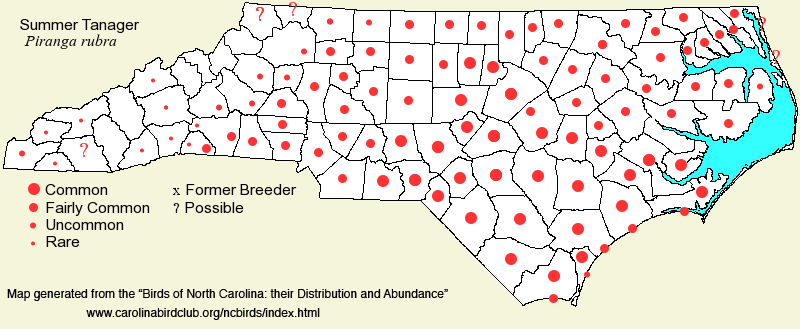 |  |
|
Summer Tanager - Piranga rubra CARDINALIDAE Members: | Search Common: Search Scientific: |
|
|
|||||||
| General Comments | The Summer Tanager is a characteristic bird of the Deep South, nesting north only to southern New Jersey and the southern Midwestern states, but as far west as southern California. It breeds over nearly all of North Carolina, but it is scarce in the mountains and is absent in some of the higher-elevation counties. It is most common in the southeastern portions of the state, favoring dry to somewhat mesic forests and open woods, from Longleaf Pine stands to oak forests. It is less common in floodplain forests and other dense forests, but it does nest frequently in wooded residential areas. In the foothills and lower mountains, it breeds mainly along streamside woods in valleys, and not on forested slopes. The species winters in the tropics, but with more people feeding birds in winter, there has been an increasing number of such records in the state, though still only one or two per season, on average. | ||||||
| Breeding Status | Breeder | ||||||
| NC BRC List | Definitive | ||||||
| State Status | |||||||
| U.S. Status | |||||||
| State Rank | S5B | ||||||
| Global Rank | G5 | ||||||
| Coastal Plain | Summer resident, and winter straggler. Common in the southern half of the region, from the Croatan National Forest in the east to the Sandhills region in the west. Fairly common in the remainder of the province, but generally uncommon to locally fairly common in the Tidewater region; absent, to rare and local, breeder along the Outer Banks and most other barrier islands. Mainly early or mid-Apr to late Sep. At least 26 winter records, mostly near the coast, and mainly at feeders; a few do manage to overwinter at feeders. Peak counts: | ||||||
| Piedmont | Summer resident, with a few winter records. Fairly common to common over most of the region, more numerous (often common) in the eastern portions, and uncommon to fairly common in the far western areas, including the foothill ranges (where generally uncommon). Mainly mid-Apr to late Sep. Apparently 13 winter records, mostly at feeders. Peak counts: | ||||||
| Mountains | Sparse summer resident, with little migratory movement noted. Uncommon in the extreme southwestern counties, such as Cherokee; elsewhere, rare and local, mainly below 2,000 feet, north to about the French Broad River; essentially absent in the northern half of the mountains, except sparingly along the New River in Ashe and Alleghany, if reports are/were correct. One singing and calling on the Boogerman Trail (Haywood) on 11 May 2024 was at a rather high elevation. Exact details of its breeding range are still somewhat uncertain, as most summer records on eBird are "soft" with no details mentioned; were they misidentified songs of Scarlet Tanagers?. Very rare migrant in fall at middle and higher elevations. One winter record: a female at a feeder in Leicester (Buncombe) from 22 Jan to late Feb 2010*. Mainly mid-Apr to late Sep. Peak counts: | ||||||
| Finding Tips |
None needed in the southern Coastal Plain, such as in the Sandhills Game Land, Weymouth Woods Preserve, or Croatan National Forest. **** | ||||||
| Attribution | LeGrand[2025-05-09], LeGrand[2025-02-06], LeGrand[2024-11-11] | ||||||
| NC Map Map depicts all counties with a report (transient or resident) for the species. | Click on county for list of all known species. |
| NC Breeding Season Map Map depicts assumed breeding season abundance for the species. |  |